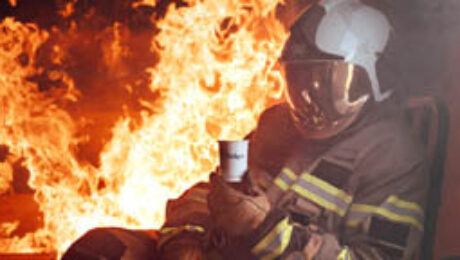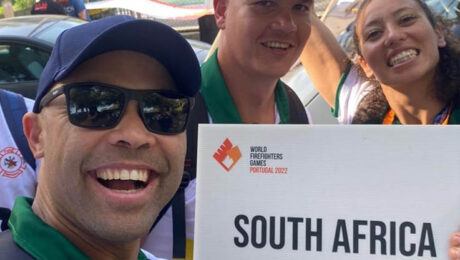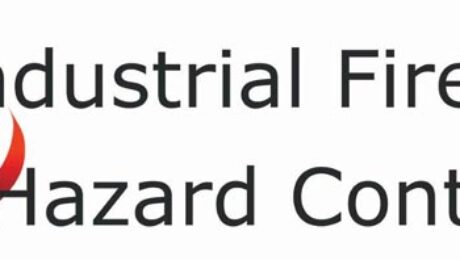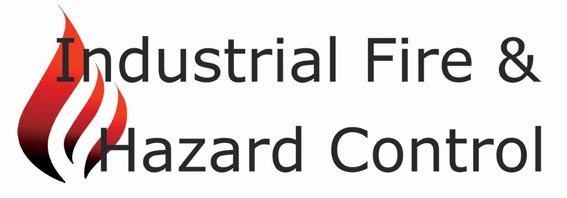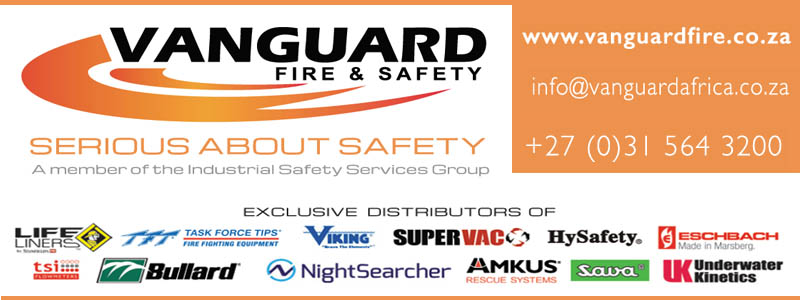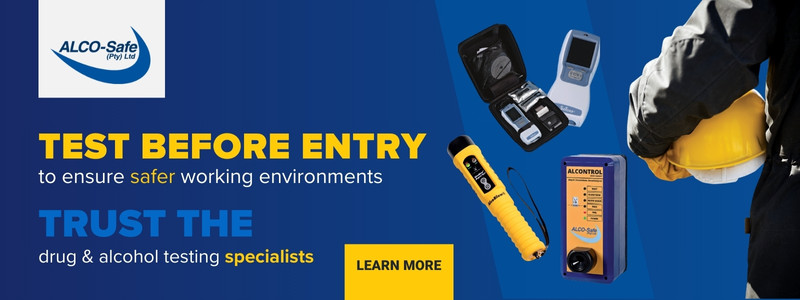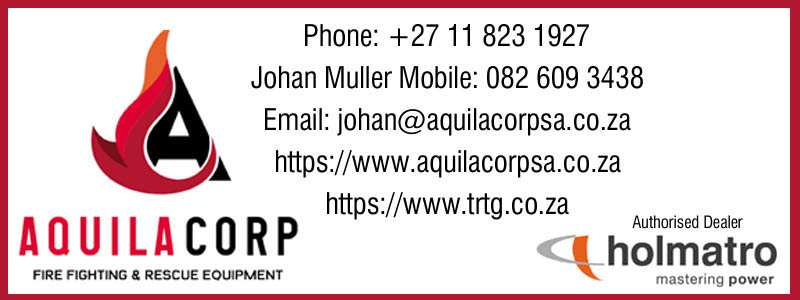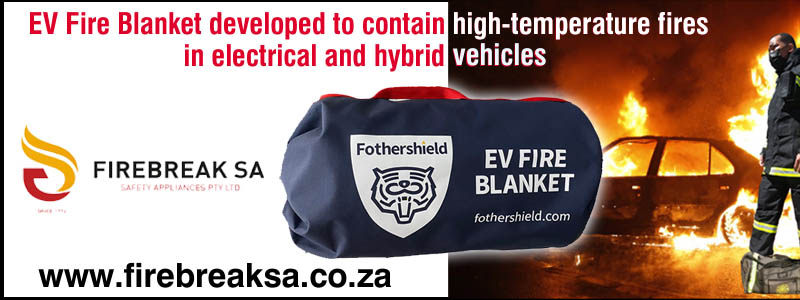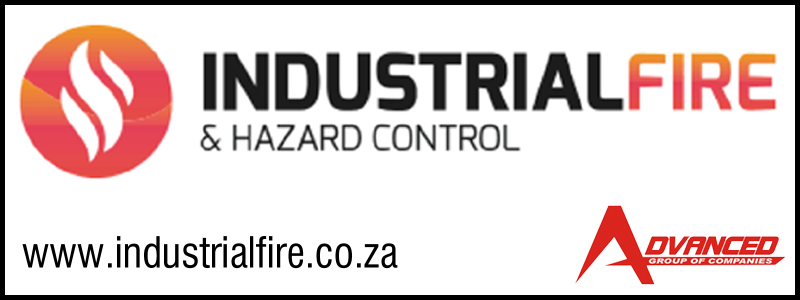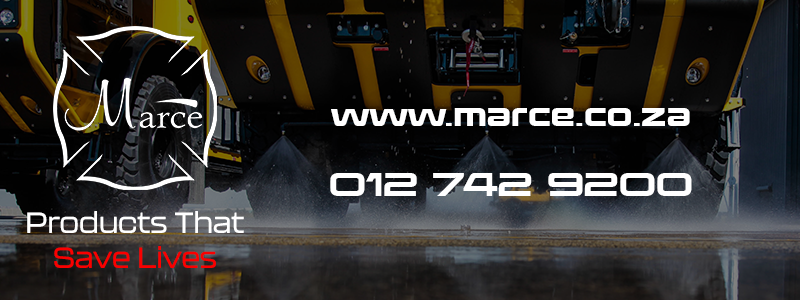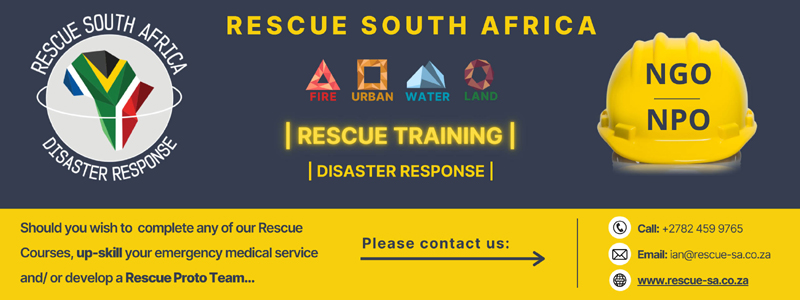Dräger UCF® FireCore hands-free thermal imaging camera
Nothing can hold you back

The Dräger UCF® FireCore hands-free thermal imaging camera gives you a permanent vision of your immediate surroundings, even under the toughest conditions. That allows you to orientate yourself more quickly and safely, while also improving your situational awareness.

Rapid assessment of the situation during firefighting
Especially during firefighting, difficult conditions such as fire, smoke and darkness prevail. The UCF® FireCore provides important orientation, helps to quickly assess the situation, and thus identify potential hazards.
High level of flexibility.
No matter whether you are crawling or climbing stairs, you always have a complete overview, because the camera angle is flexibly adjustable. This reduces physical strain, such as neck pain.
Thermal imaging camera is easily detachable.
Especially when firefighting you often need to enter areas that are difficult to access. The UCF® FireCore makes it easier to manoeuvre, because you can simply detach it to capture a view of what is waiting in hard to reach areas. That gives you even better situational awareness.
Learn More Here : https://www.draeger.com/en_za/Products/UCF-FireCore
Our Solutions for Fire Services


Learn More : https://www.draeger.com/en_za/Fire-Services
- Published in Uncategorized
Register now for the EMS Conference 2024
Dates: 23-24 July 2024
Venue: Dräger Auditorium, Sandton
Cost per delegate: R6900
Theme: QUO VADIS: The future of Fire Safety and the Emergency Services: Solutions and Innovations
The Safety First Association invites anyone involved in fire safety and the emergency services to attend this much-needed and overdue conference.

Municipal fire department officers and personnel, proto fire fighting teams, industrial firefighters and team leaders as well as OSH personnel will benefit from attending.
Attendees will leave with a wider knowledge, understanding and improved capabilities of technology which is advancing in leaps and bounds. Attendees for example will learn about lithium battery and car battery fires, as well as how AI and drones can help prevent and fight fires.
Attendees will also listen to experts share their knowledge and experience. They will hear how navigating the emergency services through difficult times has led to the growth of the private services and how this impacts on insurance, risk and response.
Other presentations will include:
• Disaster response to understanding and adapting to evolving weather patterns.
• Fire fighter health and mental well-being.
•Prevention of diseases suffered by fire fighters.
• Training requirements.
• Community education in prevention of fires.
• and many others.
To get a full programme of all presentations and presenters send an email to debbie@safety1st.co.za or telephone 083 266 6662
or submit the application form on https://safety1st.co.za/events/ and we will get back to you.
- Published in Uncategorized
LATEST EMS BUYER’S GUIDE NOW AVAILABLE
The latest copy of the Emergency Management Services Buyer’s Guide is now available to download.

Containing information on the latest products and services to the emergency services, it is an invaluable aid to anyone involved in the emergency services.
Click below to download:
- Published in News, Uncategorized
EMS CONFERENCE 2024
Theme: QUO VADIS: The future of the Emergency Management Services in Africa – Innovations and Solutions

Due to its long history in occupational health and safety encompassing fire safety, the Safety First Association is organising a conference for this all-important industry. The aim is that in our modernising and changing world, knowledge and experience can be shared among employees from EM departments in both industry and municipality.
The conference will be held from 23-24 July 2024 in Dräger’s auditorium Sandton, Johannesburg. It will be followed on 25th July by Dräger’s fire fighter challenge.
Our aim is for delegates to leave with a wider knowledge, understanding and improved capabilities. The conference will also offer an opportunity for product demonstrations and networking.
The conference will cover a wide range of subjects related to the emergency services such as:
• Fire fighting techniques in new building structures
• Keeping up with the sciences.
• Improved fire fighting techniques in older/delapidated buildings
• Modernisation of EMS services and challenges.
• Forestry fire fighting
• Disaster management. Changing weather conditions.
• Training. Changes to requirements.
• New standards. Changes to standards (International & local)
• Tender management / Tender submissions: Ensuring deliverables meet expectations/standards or approvals
• Rescues
• Product innovations
• Hazmat transportation and storage
• Risks – property and employee
• Fire fighter safety
• First responder stresses
• Legal pitfalls
• Leadership skills
and more.
For further information contact: Debbie at +27 (0) 83 266 6662 or email debbie@safety1st.co.za
For further information on Sponsorship opportunities, click below:
- Published in News, Uncategorized
Lessons learnt from the Boksburg gas tanker explosion
Firstly, may we, the Safety First Association and its members express our shock and sincere condolences to those who lost family members due to the gas tanker explosion on 24 December 2022 in Boksburg. Our thoughts and prayers are with you all and we hope and trust that those who are injured and traumatised will recover soon.
In South Africa, we have various vehicles transporting hazardous materials daily. Most people have no idea of the risks related to the types of dangerous and hazardous goods being transported on our roads, what could happen should an accident event occur, and even how they are transported. Hazardous gasses are transported in pressurised LPG tankers, carbon dioxide tankers, oxygen, chlorine and acetylene tankers. While others may be transported in a liquid form in pressurised tanks or cylinders on trucks and even bakkies. Then we have the large tankers carrying flammable liquids such as petrol, paraffin, solvents, diesel and jet fuels, etc. in unpressurised tanks. There are also trucks carrying solid and powdered materials like ammonium nitrate and explosives. Corrosive acids and alkalis also have to be transported. Any of these tankers or vehicles can and have been involved in unfortunate incidents in the past.
I waited a few days since the Christmas eve gas tanker explosion incident for incident information to be publicised, so that a logical incident assessment can be made, based on the information available and my insights as an experienced incident investigator. In time, the other formal incident investigations should provide the actual incident causes going forward.
What happened?
Stitching together the press and media reports let’s perform an assumed gas explosion incident scenario assessment.
The incident background involves a gas tanker reported to be travelling from Richards Bay to Botswana in a contracted haulage carrier company’s Hazchem (hazardous chemical risks labelled) designated tanker vehicle with non-company employee driver who was reported as a suitably trained, licensed and professional permitted driver with reported some 7 years of driving experience, apparently obtained from a third-party Employment Agency. At this stage we are unaware of the hazardous goods travel route and had the route been formally risk assessed and approved for use. Secondly, we are still uninformed to what extent the tanker driver was informed and instructed on the assessed and approved travel route, which should have at least one overnight rest stop due to the travel distance involved.
It is assumed the travel route was not along the N3 from KZN, but from Richards Bay via Mpumalanga, which is likely why the tanker was passing through the Boksburg area. I was recently in the East Rand area and got lost as the road signage is poor to non-existent. That being the case, the employment agency driver could have easily got lost and taken a wrong turning, ending with the tanker being caught under a low height capacity bridge with poor warning signposts. A pre-incident bridge photo that has been published shows a small and poorly visible warning sign displayed on the bridge parapet railing. The bridge’s concrete beam also shows damage where numerous previous vehicles would have impacted with it. Furthermore, the published photographs of the bridge site display a steep road profile decline entry into the bridge, which means the long tanker has its back wheels up the slope adding to the tanker’s height on entering under the bridge. Another published photograph of the tanker wedged under the bridge shows possible evidence of fire flames, so the fire ignition may have been caused as the tanker got stuck under the bridge. Apparently, the driver realising there was a gas leak and a serious incident risk immediately called for emergency help. He was also said to be involved in deploying barrier tape and warning the spectators to evacuate the area as gas was escaping. But without any heeding his warning, they became victims. Such actions suggest the driver was risk trained and so took the appropriate incident prevention actions.
On arrival of the emergency services (fire brigade and police), they automatically become the incident site custodians to manage the site and the risks. This would involve managing the gas leak and fighting the fire when it occurs, as well as managing and stopping road access to the site, and due to the gas risk enforcing the evacuation of the area of all the bystanders, etc. But, it appears that no enforced bystander or other evacuation was implemented.

Why did the gas tanker catch fire and explode? Safety things to note:
1. LPG is stored as a liquid under pressure in pressure tanks, tanker cylinders and in the domestic and other gas cylinders used by us all. When the gas pressure is released the LPG liquid rapidly vapourises into a gas that occupies about a 270 times larger gas volume than a 1 litre of LPG’s liquid volume. It is believed that the driver knowing the risk therefore called for the emergency services help to manage the incident.
Note: The Emergency Management Services adopt the commanding and managing responsibility of any incident site on their arrival.
2. LPG is heavier than air so it will sink and accumulate into the lower lying areas under the bridge, and when the gas vapour is at a 2% to 9.5% mixture in air it only needs a nearby spark, a spectator cigarette or something at some 450°C to ignite it.
LPG being a heavy gas would raise oxygen out from under the low bridge area, giving an oxygen deficient atmosphere such that nearby vehicles were not able to be started, as was reported by taxi driver/s who lost their vehicles in the explosion. And for this same reason, the driver was hospitalised as he was reported to suffer from an oxygen deficiency exposure.
3. On ignition the accumulated leaking gas, from an unknown source, possible from a hot exhaust, electric spark or cigarette, etc., the leaked LP Gas will flash back to the leaking tank, heating the tank (as the flames and heat, about 1 980°C, was confined against the tank against the bridge’s concrete deck base), where pressurised LP liquid in the tank is heated, and with reducing gas leak pressure, the LPG liquid rapidly changes to LP Gas which will over pressure the metal-weakened fire-heated tank until the tank ruptures causing a fire related BLEVE (Boiling Liquid Expanding Vapour Explosion). This then generates a massive high heat and energy fire ball of several hundred meters in diameter, due to the tanker volume of LPG involved.(Note, steel melts at about 1600°C).
Considering this assumed incident sequence of events, now leaves us with questions from which lessons can be learnt.
Incident lessons that can be learnt
Lesson one:
The authorities and the public are relatively unaware of the risks related to the transportation of hazardous materials through their town and community areas – in this tragic case Liquid Petroleum Gas (LPG). What are the dangerous and hazardous goods that are transported daily in your area? Are they being transported through your community high-risk areas? Have specific approved high-risk transportation routes been established and their use enforced? Are these vehicles suitably approved and permitted to transport such hazardous goods?
Lesson two:
Was there an adequate hazardous good transportation route and driver knowledge and capacity assessments done? Currently, we are unaware if there was any transportation route risk assessment performed by the transport contractor. Was the route selected a normal transportation route or was it changed due to a holiday season quiet route from Richards Bay to the Reef, so to avoid the busy N3 traffic routes via Durban? It seems possible that the route selected involved the driver travelling through Mpumalanga ending in Boksburg, where I recently got lost travelling from the N17 towards the N12 as the road route signage is poor. Question: was this route the normal tanker route or an adapted one so as not to subject the festive season traffic on the N3 to a hazardous load risk? Had the authorities perhaps placed a limitation on the heavy transport haulers using the N3 during this festive season period, and thereby forcing the transport contractor to use other less familiar and possible non-risk assessed routes? There are many lessons to be learnt within this second lesson learning point.
Lesson three:
Assuming the driver got lost, took a wrong turning and got his tanker wedged under a low level clearance height bridge with warnings poorly marked. Press photos show the tanker wedged under the bridge, with no obvious fire ignition showing, although it is obvious that some valve on the tanker top was damaged and so it was leaking LPGas into the atmosphere. The knee jerk response is/was to blame the driver for the deaths (now standing at 34). Yes, he wedged the tanker. No, he did not deliberately or intentionally start the fire. He apparently acted responsibly by highlighting the gas risk and so implementing “keep clear” precautions until the emergency services arrived. He was not responsible for the site after the emergency services (fire brigade and police) arrived and started managing the site. He had no authority to order a site evacuation. However, the general feeling is everything that happened is his fault. This lesson suggests there are more root causes to this incident than just putting the blame on the tanker driver.
Lesson four:
Was the fire-fighting adequate? LPG is an E class fire which is normally extinguished by shutting off the gas supply or by firefighting using dry powder, or carbon dioxide, or foam into the gas stream to extinguish the gas fire. In this incident, water hoses were used in an attempt to keep the tanker’s tank cool, but this would not extinguish the gas fire. Unfortunately, the gas leak fire was against the bridge base, so the flames and fire heat were in contact with the metal tank surface now being heated, thereby softening the metal until the tank under pressure ruptured, releasing the gas liquid to cause a BLEVE and its huge fire ball and explosion which destroyed lives and property. The lesson is that fire-fighting must always consider the material burning and the environment impacting on extinguishing a fire.
Due to the gas leak fire location in this scenario, there was a slim chance of extinguishing the fire whereas a tank rupture and explosion was a likely outcome. Therefore a full area evacuation was required but was not ordered and/or effectively implemented, resulting in damage and fatal injuries from the BLEVE, which caused an explosive shock wave and intense fire balls impacting everything in at least a 100m diameter area. The explosion shock blast caused the roof and ceilings of the nearby Tambo Memorial Hospital to be blown off with some walls collapsing. The bridge, railway lines and nearby vehicles were destroyed. Surrounding houses were damaged. People in close proximity were either burned or killed.
Lesson five:
Did the bridge display adequate and obvious warning signs indicating its low clearance and clearance height dimensions? Media pictures show a poorly visible bridge warning sign which many drivers had obviously not seen because the bridge’s concrete beam can be seen as damaged multiple times from vehicle impacts. That suggests the warning signage was totally inadequate and should have been upgraded to suitable visible signage by the municipal authorities. With the height warning signage being in a poor state, the driver could easily have misjudged the height clearance for his tanker truck, which was evident in the photo of the truck under the bridge. Knowing that the signage was inadequate, why did the local council (traffic department) not improve the low bridge warning signage with clear visible warnings on the approach road?
Will the bridge be rebuilt as per the destroyed one, another low-level clearance bridge? More than likely, because of the railway lines alignment issues. If so, more bridge vehicle collision contacts can be expected. An over-the-rails design bridge is required to eliminate this low bridge hazard, but at a significant cost.
Lesson six:
Are the local authorities and emergency services up to speed to handle such incidents? The media has been asking such questions for a while now, as it is known that suitably trained and experienced staff shortages and equipment supply and maintenance funding issues exist and are known concerns in nearly every South African municipality and town council. Was fire-fighting foam available for use at this incident site? We also ask, when will the destroyed fire water tanker be replaced following this incident?
Conclusion
This assumed incident risk assessment highlights that many factors, like evidence, forensics, witness and response statements, etc, will need to be considered, by the hopefully experienced incident investigators, during the formal incident investigation and its issued report.
Let us hope that some points from this incident risk assessment of assumed questions and lessons will be considered during the investigations and implemented going forward in memory of those who tragically died.
By Leighton Bennett, the Safety First Association Chairperson, and a professionally registered OHS Professional and Risk Management Consultant.
www.safety1st.co.za

- Published in News, Uncategorized
Divetek Compressors
Divetek Compressors was the brain child of Andre Vosloo, under his guidance with David Cohen the Director of Divetek Pty – David Cohen – Divetek Compressors was born. Initially Andre simply “freelanced” as a compressor technician since leaving a major competitor in 2016.
With the recent joining of Corné Grobbelaar to the team it was evident that there was a lack of technical expertise available within high pressure applications in South Africa not only within the “breathing air” systems but also within industrial and military systems.
We have grown from strength to strength and now provide comprehensive services within the industry.
Divetek now as a group of companies and multiple branches provides turnkey solutions both within the scuba industry and within high pressure applications.
We also import and hold distribution rights on a number of major brands, Faber Cylinders, Luxfer Cylinders, Midland Diving Equipment, OTS Ocean Technology Systems, Paramina Compressors, Orca Torch, Deepblu Diving Computers, San-O-Sub Diving Equipment, as well as our own range of imported Divetek Diving Gear.

Our Johannesburg premises has been recently extended and now covers 1400sqm from where stock is on hand and we supply directly to the public – visit www.divetek.co.za for a full listing of products and services available.

Contact Divetek Compressors
Unit 14, Skyview Retail Park,
CNR CR Swart and Freda Road. Bromhof, Johannesburg.
Tel: +27 (0)11 791 1095
Email: sales@divetek.co.za / compressors@divetek.co.za
- Published in Uncategorized
Sysman for 911 and Disaster Management solutions
Sysman is renowned for providing robust, facility-rich and affordable 911 and Disaster Management solutions which it has been doing for the past 34 years.
The effectiveness of an emergency control system is governed by many factors. These include quality and reliable applications all of which must be tightly integrated into one homogeneous system. To this end we offer a portfolio of solutions, some highlights being:
• ESS: a web-enabled, 911 call taking and despatching solution, with a real time, electronic video wall, comprehensive reporting, integrated maps with GIS capabilities, Mobile Data Terminal integration, a clean graphical interface and much more.
• iFIG: an IP based Station Control system fully integrated with ESS. It offers Bells, PA, Intercom, Bay doors, lights, robots, access control and more.
• Mobile Data Terminals: integrated with ESS supporting despatch notes, status updating, on board, voice guided navigation to an incident scene. devices are GPS tracked. Streaming video from an incident scene is also supported. Companion app on devices carried by responders allows for data capture and communications with the control centre and each other without the need for radios.
• Fleet Management: integrated with ESS. GPS vehicle tracking and vehicle stats and driver behaviour reports such as harsh braking and over speeding. Fuel and Workshop Management Modules also available.
• WAVE: a Radio over IP and Voice over IP solution supporting different types of radios on different channels and inter-operability between two or more emergency services. Supports multiple devices including existing radios, laptops and PCs and Smart Phones. Use a smart phone as a radio by pressing a soft PTT button. Widely used by the emergency services, the military and airports throughout the world this solution is has now been installed by Sysman in various sites around South Africa.
• Disaster Management: a web enabled, internationally acclaimed Disaster Management system which can be operated from anywhere such as an office, field or JOC centre. It is a unified command system which improves role player coordination, response and information sharing. Departments can plan for events/disasters and the like but can also activate a fast response to unplanned events. The mass communication required during such events/incidents/ disasters is a ‘must-have’ tool for every disaster management organisation. So too is effective feedback from the disaster scene using cellular devices
• Service Call Management: an application which enables services calls to be scheduled; allocated to service personnel (each of whom carry a tablet device); for work performed during a service call to be captured and transmitted via the Cloud to the service centre, together with many other facilities that maintains communication with all parties and permits performance monitoring. The software is adaptable to any type of service call.
• REMRAD: a completely revised and updated solution that links the fire detection systems in commercial and industrial premises to an emergency monitoring centre. The system can be monitored by up to four emergency centre (typically fire, police, ambulance and security) and supports two-way speech. The new system operates in the cloud using cellular networks. Automatic switching between networks is supported for failsafe and redundancy reasons.
Our 2018/19 portfolio of solutions will impress and may even surprise you. Invite us to talk to you or arrange to visit one of our many installations. You will find us knowledgeable and capable of delivering high quality solutions that will materially assist with your goal of improving service delivery to residents within your area of responsibility.
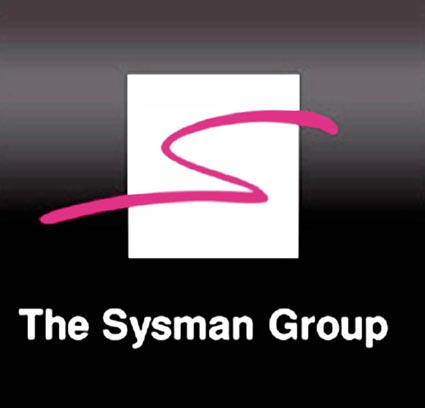
Contact Sysman
Tel: +27(11) 300-3300 or 0861-SYSMAN
Fax: +27(11) 219-7430
Email: sales@sysman.co.za
- Published in Uncategorized
World Fighter Games
Charnaud have proudly congratulated their ambassadors Baigum Abrahams and Emile Conrad who competed their hearts out at the WORLD FIREFIGHTERS GAMES.
Both attained amazing results.
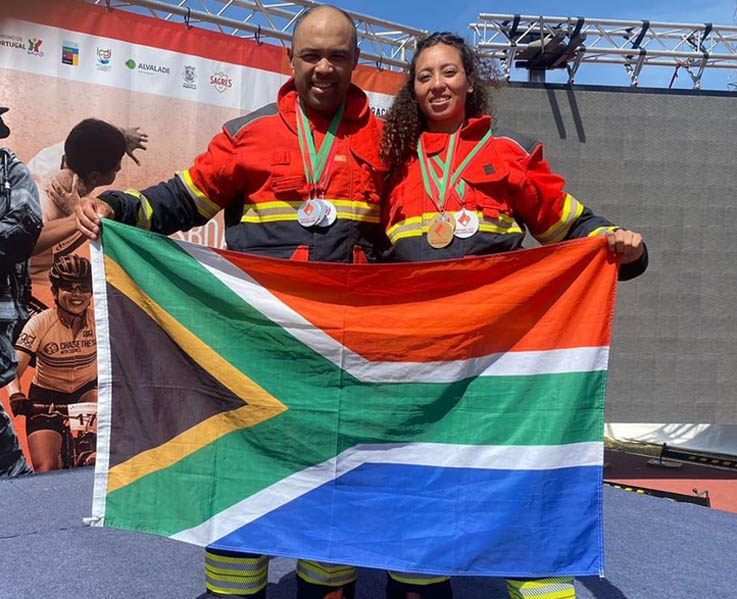
Baigum received the following medals:
1 x silver for 100m sprint
1 x silver medal for mixed tug of war
1 x gold for 200m sprint
1 x gold for 400m relay
1 x gold for female tug of war
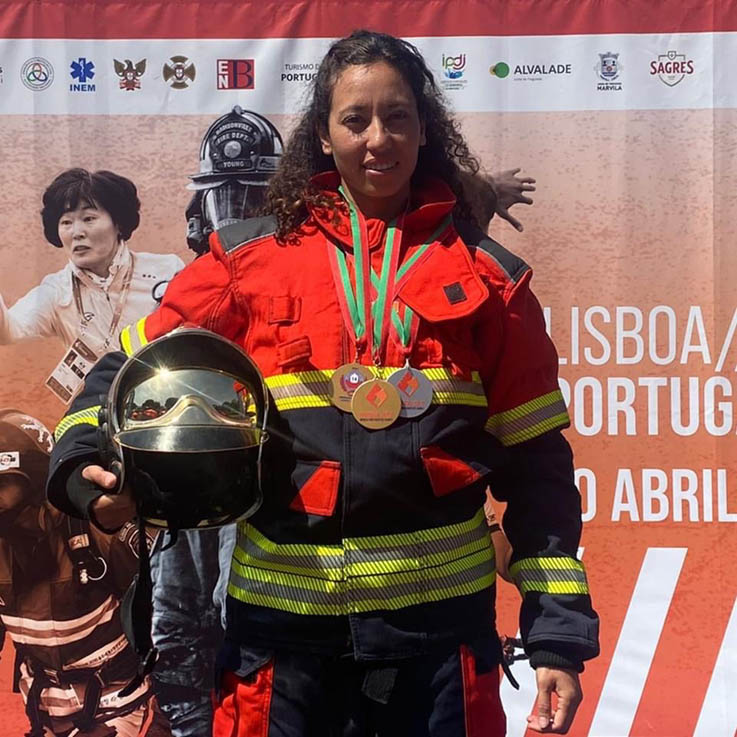
Emile achieved the following:
10th overall in Toughest firefighter Alive competition
1 x Silver medal for Toughest firefighter Alive in his age category
1 x Silver medal for overall indoor rowing event.
1 x Silver medal for Stair running event in his age category.
1 x Gold medal for tug of war mixed team.
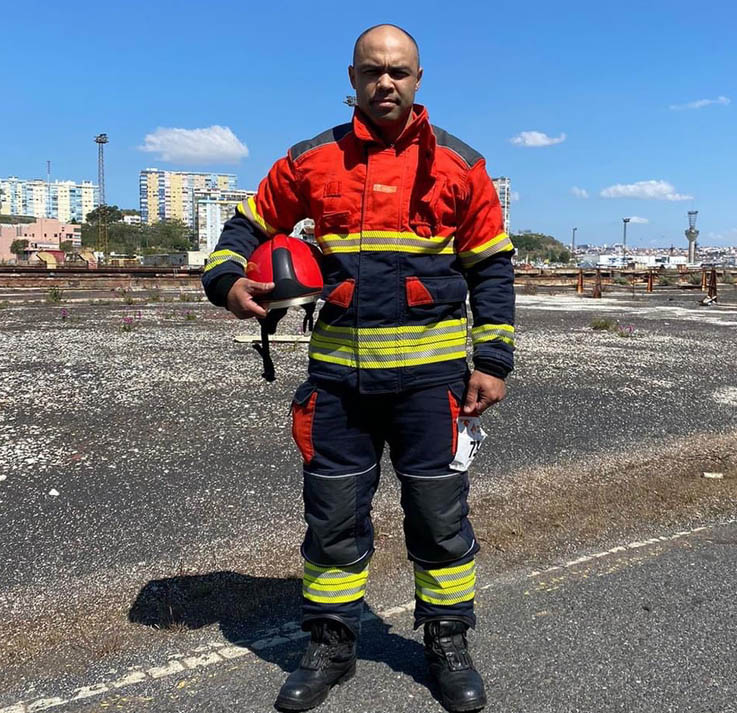

- Published in Uncategorized
Firebreak – for fire safety solutions
Firebreak SA (PTY) LTD, a BBBEE Company was founded in 1996 to provide quality products and great service which exceeds the customers expectations. Our knowledgeable sales staff have a combined 100 years of experience within the fire and safety industry.
Click here to download Firebreak SA’s brochure:
Firebreak is in business to provide a total package of safety and fire solutions. Their product range encompasses a wide range of products such as permanent and portable breath testers; gas detection equipment; chemical suits; fall arrest devices; confined space escape products and much more.
Firebreak SA provide training and full service back up to this range of equipment:-
• Scott Agent (SCBA’s) / 3M Products
• MSA Agent (SCBA’s / Gas Detection)
• LIFELOC Portable and Permanent Breath Testers
• DU PONT range of chemical suits
• TFT / Vanguard Fire Fighting Products
• Bullard / Viking Fire Protective Equipment
• LYMAE Advanced Fire Protective suits & coveralls
• KARAM Fall Arrest / Height Safety Solutions
• Darley (ex-USA) fire tools (Hooligan Tools/ Axes / Pike Poles)
• Fire Servicing / Inspections / Detection systems (SABS Accredited)
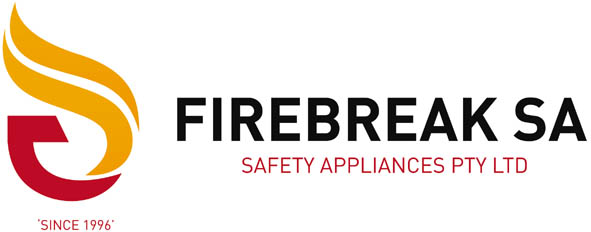
Contact Firebreak SA (PTY) LTD …
Offering exceptionally fast service backed up by “staff steeped in experience” … willing to help you solve your every problem.
Tel no: +27 (0)11 908 6960 or visit their website www.firebreaksa.co.za
Team Members:
Duncan Ramsden: +27 (0)82 787 6484 / duncan@firebreaksa.co.za
Blane De Meillon: +27 (0)79 493 7958 / blane@firebreaksa.co.za
Paddy Mallett: +27 (0)63 692 5304 / paddy@firebreaksa.co.za
Freddie Allworth: +27 (0)82 568 0164 / freddie@firebreaksa.co.za
Ramesh Jeram: +27 (0)82 880 2723 / ramesh@firebreaksa.co.za
Duane Basson: +27 (0)82 253 6885 / duane@firebreaksa.co.za
Josh Mahlangu: +27 (0)72 126 9459 / josh@firebreaksa.co.za
Etienne Jacobsz: +27 (0)82 880 2696 / etienne@firebreaksa.co.za
Darren Rogers: +27 (0)71 244 0789 / darren@firebreaksa.co.za
Donovan van der Schyf: +27 (0) 82 574 0782 / donovan@firebreaksa.co.za
- Published in Uncategorized
Industrial Fire & Hazard Control your single source solutions company
Industrial Fire & Hazard Control, a proud member of the Advanced Group of Companies, is intently focused on mitigating risk in the fire, rescue, hazmat and disaster management arena. We strive to render an in-depth subject matter knowledge base, the prerequisite skills set, access to technologically advanced products, world-class service rendering and the passion to serve in order to meet our clients ever growing requirements. For Industrial Fire & Hazard Control there is no room for error, no room for anything less than the very best . . . our clients demand it and we deliver on it!
We are by no means a seven-to-five company, everything that we do is personal, every interaction, every product that we manufacture and supply; our people are personally involved and take ownership and responsibility because our products are used to save lives and property. We are serious about our business because you are serious about yours. We have a PASSION for the fire, rescue, hazmat and disaster management industry and, as a level 2 B-BBEE company, we take our Codes of Good Practice seriously. As we continually strive for excellence, we are making a difference to everyday lives, one product at a time.
Industrial Fire & Hazard Control … there when you need us!
Visit us at www.industrialfire.co.za ; The Home of Imagineering.”
- Published in Uncategorized

